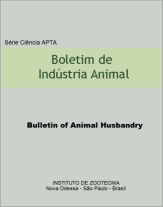Use of two sources of urea in the diet of crossbred lambs finished under a semi-intensive system
DOI:
https://doi.org/10.17523/bia.v72n1p8Keywords:
Dorper, encapsulated urea, meat quality, Texel, weight gain.Abstract
This study compared the effect of genetic group and diet containing two sources of urea on the performance, carcass and meat traits of lambs. The experiment was conducted at FAZU, Uberaba, MG. Twelve crossbred Dorper and 12 crossbred Texel lambs, obtained by the crossing of Santa Inês ewes with pure rams of each breed, were divided into two groups and maintained on Ãries paddocks (Panicum maximum cv. Ãries). The animals received concentrate containing ureia or encapsulated urea ad libitum. A completely randomized factorial design was used, in which the two sources of non-protein nitrogen and the two genetic groups (Dorper or Texel crossbreds) were evaluated. Means were compared by the Tukey test at a probability level of 5%. The treatments did not influence daily weight gain (0.256 kg/day). The use of encapsulated urea increased hot and cold carcass yield when compared to the diet containing urea. Cooling losses were lower for Texel crossbreds (3.87%) compared to Dorper crossbreds (6.88%). Fat thickness (1.81 mm), conformation (2.98), L value (36.77), a* value (6.04), b* value (6.73), or shear strength (5.68 kgf) was not altered by the treatments applied. Encapsulated urea provided a higher carcass yield and lower cooling losses.Downloads
Downloads
Published
Issue
Section
License
Os autores não serão remunerados pela publicação de trabalhos, pois devem abrir mão de seus direitos autorais em favor deste periódico. Por outro lado, os autores ficam autorizados a publicar seus artigos, simultaneamente, em repositórios da instituição de sua origem, desde que citada a fonte da publicação original seja Boletim de Indústria Animal. A revista se reserva o direito de efetuar, nos originais, alterações de ordem normativa, ortográfica e gramatical, com vistas a manter o padrão culto da língua e a credibilidade do veículo. Respeitará, no entanto, o estilo de escrever dos autores. Alterações, correções ou sugestões de ordem conceitual serão encaminhadas aos autores, quando necessário. Nesses casos, os artigos, depois de adequados, deverão ser submetidos a nova apreciação. As opiniões emitidas pelos autores dos artigos são de sua exclusiva responsabilidade. Todo o conteúdo deste periódico, exceto onde está identificado, está licenciado sob a Licença Creative Commons Attribution (CC-BY-NC). A condição BY implica que os licenciados podem copiar, distribuir, exibir e executar a obra e fazer trabalhos derivados com base em que só se dão o autor ou licenciante os créditos na forma especificada por estes. A cláusula NC significa que os licenciados podem copiar, distribuir, exibir e executar a obra e fazer trabalhos derivados com base apenas para fins não comerciais.













